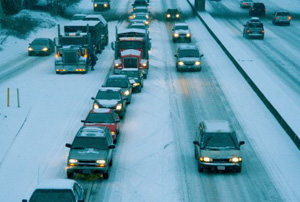
Recently, ABC News reported that 35 people were injured in a huge car pile-up that occurred on the Bronx River Parkway just outside of New York City. Authorities explained that the terrible driving conditions, including cold temperatures and icy roads, were responsible for the incident. Many similar car crashes are occurring in many states, as harsh winter weather sweeps across the nation.
With winter now here in full force, it is critical that all drivers review some basic safety guidelines for driving in inclement weather. Every year in America, there are over 6 million car crashes. Nearly 25% of these crashes come as a result of inclement weather, including fog, rain, and snow. The US Department of Transportation reports that over 7,000 people are killed annually in weather-related accidents, and over 600,000 people are injured.
These statistics should serve as a wakeup call to all motorists. Drivers can reduce the number of fatalities and injuries by taking the time to review safe driving guidelines, and by exhibiting higher levels of caution while on the roads. Here are some of the most important safety considerations to keep in mind during adverse weather conditions:
Snow Tires
For those drivers with the ability to switch their regular tires for snow tires, these can greatly improve driving safety. Snow tires provide an added level of traction for winter weather. Increasing your car’s traction on the roads prevents slipping and subsequent collisions.
Anti-lock Brakes
Some cars come with preinstalled anti-lock brakes. Unlike regular brakes, these brakes automatically detect skidding and react by exerting and releasing pressure in rapid succession. This safety feature prevents further slipping and helps your vehicle regain the traction that you need in order to safely control the vehicle.
Of course, not all brakes have an antilock system in place. And even for those vehicles with anti-lock brakes, skidding can still occur. In these scenarios, it is important to know how to operate your vehicle safely. The New York State Department of Motor Vehicles offers the following guidelines:
*****If your rear wheels are skidding on ice, steer your front wheels into the same direction of your car’s skid. Be sure to adjust the steering wheel as the car begins to center itself. If the car’s front wheels are skidding, shift the car into neutral. As the car begins to slow down, you may then steer the wheel in the direction in which you would like to move. *****
Headlights
Always turn your headlights on when visibility is reduced due to fog, rain, or snow. Headlights will improve your ability to see other motorists, and will also help them see you. At times, putting on flashing hazard lights is also necessary. If visibility is exceedingly low, this is an advisable course of action. Also remember to turn on your hazard lights in the event that you have pulled on to the shoulder of the road. If you don’t, you run the risk of causing a car accident.
Speed
Exceeding the speed limit is both dangerous and illegal. This is true regardless of current weather conditions. However, speeding is even more dangerous during inclement weather. Be extra cautious when driving during adverse weather conditions, and be prepared to drive well below the speed limit if necessary. Driving slowly and patiently contributes to everyone’s safety, especially when it is raining, snowing, or icy. Fellow motorists, as well as pedestrians, are put at great risk by motorists who speed in wintry conditions.
Seatbelts
As always, buckle up! Wearing a seatbelt is the law in most states. This is always important, and all the more so when the risk of motorists losing control of their cars is even higher.
Consult your local authorities for a complete set of guidelines for driving in winter weather. Depending on the severity of the weather, motorists may be encouraged to avoid the roads during or soon after a storm. If it is at all possible to delay your trip during severe weather conditions, you increase your own safety as well as the safety of fellow drivers and pedestrians.



